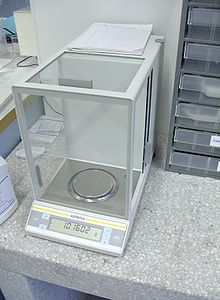Analytical balance
The analytical balance is the most sensitive form of a precision balance . With a resolution of usually 0.1 mg, it is suitable for weighing extremely small portions of substance.
Even more accurate balances that have a resolution of one microgram are called microbalances .
Older design
Analytical balances used to be beam balances . Some designs worked according to the principle of substitution: on both sides of the beam there was typically 200 grams of mass, on the side with the weighing pan you could lift fractions of this mass from the beam with a mechanism. Rough weighing was used to determine how heavy a sample is in grams, this mass was then lifted off by means of the mechanism, and the actual weighing was started by releasing a lock on the bar. Then you could use the mechanics to lift or add further small weights, but the decisive factor was a steel spring, which could be used to exert a small force on the beam to bring it into equilibrium. The controller connected to it showed how many additional milligrams or tenths of a milligram this force corresponded to. After weighing, the bar was locked again before the sample was taken.
The substitution principle prevented a one-sided deformation of the weighing beam and thus a measurement error, completely regardless of whether the sample weighed only a few grams or hundreds of grams. Nevertheless, the scales had to be recalibrated or verified on a regular basis, as the mechanics were permanently deformed and resulted in increasing measurement errors. Temperature fluctuations would have accelerated this.
Analytical balances had a spirit level , similar to a spirit level or a plumb line, on the column for alignment . The balance was then adjusted using knurled foot screws. Even the slightest inclination would have led to a considerable measurement error in terms of their measurement accuracy, and they were also disturbed by barely perceptible vibrations and, despite a closed chamber around the weighing pan, also by air currents. That is why the scales were placed on special vibration-damped weighing tables. These consist of a heavy stone slab (approx. 50 kg) that is placed in the actual frame of the weighing table with pieces of cork or other dampened soft springs. The natural resonance of this mass-spring system is below the normal building vibrations.
Weighing rooms were particularly well insulated, air-conditioned as stable as possible and mostly windowless or non-ventilated.
More modern design
Modern analytical balances work on the principle of compensated torque. The mass to be measured generates a torque that is compensated for by an electromagnetic force. This force can be measured very precisely and the measured value is quickly stable. Even modern scales need to be set up on well-damped weighing tables.
Fingerprints and humidity on the samples already lead to incorrect results, even though the balance measures correctly. Therefore, the sample containers must be cleaned thoroughly before an analysis and protected from contamination of any kind during the analysis. Furthermore, the sample containers must be completely dried in a desiccator, both empty and with the sample to be weighed, before weighing .
The applications of analytical balances are mainly chemical, quantitative analyzes, in which residues collected in a container are weighed and the previously determined mass of the container is subtracted from the measured value. The measuring range of analytical balances is basically much too precise to measure any substances for a recipe, as is done with ordinary balances, since even a small number of grains of table salt exceeds the milligram limit. However, before a quantitative wet chemical analysis, you can determine exactly how much of a substance you have used, if this is of importance for the calculation of the result. Analytical balances are practically insignificant for synthesis or qualitative chemical analyzes.

